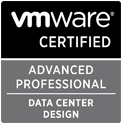I got an e-mail letting me know that I had passed my VMware VCAP5-DCA exam. Phew! I sat the exam a week before Christmas, so the news after Christmas about my pass was a belated Christmas present!
The exam was pretty much as described by the various other blog postings. The main problem I faced was time. I ended up skipping some questions due to time constraints. I wrote 1-26 on the note board and ticked them off as I went along. I did each question as it popped up unless I was not confident on being able to complete it fairly quickly. This was going well until a question on the vMA.
The question in question was related to something I had not actually done in my prep but I figured I knew enough about the vMA to complete it. I ended up spending about 12 minutes to to get the question completed but didn’t manage to. Looking back, I should have decided to move on much sooner. This wasted time resulted in me not having sufficient time at the end to complete a question I could have.
The other “blunder” I made was related to a cluster configuration. After I read the question I knew what needed to be done. I went through and completed the question and moved on. A few questions later I was back doing something else cluster related and noticed that the previous configuration which I remembered doing was missing!! So, I back tracked the questions (you can in the DCA exam but not in the DCD) and re-did the prior question – this time ensuring I clicked OK and then verified the configuration was there. I guess the first time I must have clicked “cancel” rather than “OK” in one of the dialogue boxes. Doh! So this effectively cost me another question worth of time.
I went into the exam being aware that I’d not spent enough study time on auto-deploy or image profiles. Needless to say questions related to those topics caused me to use more time than necessary. As I said previously, I ended up missing a few questions out due to time constraints. Had the remote connectivity been quicker and the exam environment been more responsive, I would have been able to do one or two more questions rather than waiting for screen redraws and so on. I’m not saying it was unusable, but more like being on the end of a slow WAN link (oh wait, the exam kit is hosted far away…). The frustrating thing was that for one of the questions my usual troubleshooting method would be to have a couple of windows open and flick between them fairly quickly, diagnosing the problem. Due to the exam environment this was not terribly feasible and I ended up skipping the question to make progress on other questions.
So, my “lessons learned” from this exam for any future DCA exams I might do are:
- Be time concious and don’t get bogged down with trying to make something work unless you are certain that you have the knowledge needed to complete the question.
- Know all the content of the blueprint fairly well. Read between the lines of the blueprint to know how the knowledge would be used in a real world situation. So, as an example do know the options for cluster fail over capacity and know how the options would relate to a real world requirements. Try and understand how the topics contained within the blueprint apply to solving day-to-day administrations problems or meeting platform requirements.
- Read through the supporting documents mentioned in the blueprint. Try to read all the entire documents at least once to get plenty of additional background knowledge.
- Ensure plenty of hands-on LAB time. Try and use the version of vSphere mentioned within the blueprint. Currently vSphere 5.0!
- Try and enjoy the exam. It does not feel too much like an exam as you are doing hands on problem solving
- Be time concious (yes, it is that important I mention it twice!)
So, how did I study for the exam? Well, I did hands-on exercises in a nested LAB environment under VMware Workstation (thanks VCP5!!). I covered the blueprint fairly extensively doing tasks based on activities mentioned in the blueprint. I also did “extra credit” type exercises where I tried to apply the knowledge from the topics for some real-world issues I’ve experienced and some hypothetical examples I thought up.
I read the following books:
- The VCAP5-DCA blueprint (A given really, for this exam!!)
- Mastering VMware vSphere 5 (a great book, the newer v5.5 edition is even better, but might taint your 5.0 knowledge for the DCA exam with newer features)
- Mastering VMware vSphere Design 2nd Ed (admittedly I read this previously for the DCD)
- VMware vSphere PowerCLI Reference
I read loads of blog posts and followed numerous VMware related twitter peeps. Here are a few of the blogs/postings which I found useful while studying. There were more, but unfortunately I don’t appear to have created bookmarks for them.
- http://www.virtuallanger.com/vcap-dca-5/ (The PDF study guide is great!!)
- http://professionalvmware.com/2012/11/vcap5-dca-study-outline-pdf/ (Another great PDF guide and a CLI guide too)
- http://wahlnetwork.com/2012/07/02/the-vcap5-dca-study-sheet/ (The study sheet is handy to tracking covered topics)
- http://www.valcolabs.com/vcap5-dca/ (another useful PDF study guide)
- http://thefoglite.com/vcap-dca5-objective/
- http://blog.mwpreston.net/8-weeks-of-vcap/
- http://nickmarshall.com.au/vcap5-dca-study-guide/ (vBrownbag sessions – great stuff, but be aware that not all the blueprint skills and abilities are covered)
- http://www.myvmwareblog.com/2013/01/11/what-documents-are-available-in-the-vmware-vcap5-dca-exam/ (Documents available during the exam)
- https://communities.vmware.com/docs/DOC-9279 (interpreting ESXTOP statistics)
- http://thesaffageek.co.uk/vsphere-5-study-resources/vcap5-dca-objectives/
- http://damiankarlson.com/vcap-dca4-exam/ (VCAP4 focussed but useful content nonetheless due to vast overlap)
- http://www.yellow-bricks.com/2011/08/25/using-vsphere-5-auto-deploy-in-your-home-lab/ (LOADS of other useful stuff on www.yellow-bricks.com too)
- http://www.demitasse.co.nz/wordpress2/2013/04/vcap5-dca-workshop/
- http://blog.vmpros.nl/2011/07/13/vmware-creating-iscsi-network-in-vsphere-esxi-5-0/
- http://cormachogan.com/2013/07/10/getting-started-with-vscsistats/
And useful for those nested ESXi labs – VMware Tools for ESXi
Hopefully the above will be useful to someone in the future!!
